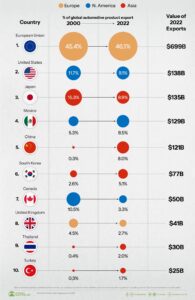
While the government has been actively pushing to ramp up domestic manufacturing to make India a global hub, exports of passenger vehicles seem to have hit a speed breaker. In 2023, the share of car exports reached its lowest point in a decade as a ratio of domestic production. This is despite the government’s ambitions to transform the country into a global auto manufacturing hub. In fact, India’s share of production geared for export is the lowest among its Asian peers such as South Korea, Thailand, Japan, and Indonesia.
In Japan, one in every two cars produced in 2023 was exported. In South Korea, two out of every three cars were exported, and in Thailand, 61% of all manufactured vehicles were sold outside the country. In contrast, of the total passenger vehicle production in India, exports accounted for a mere 13% in 2023, even lower than the preceding year’s share of 14%. Car exports were higher before the pandemic, with India exporting 18% of its output. The peak was in 2014, with exports comprising 19% of production, a record that remains unbroken.
READ | India’s current account deficit: A global challenge, domestic opportunity
Can India become a hub for car exports?
India’s automotive sector faces significant supply chain bottlenecks, which hinder its ability to compete globally. The lack of efficient logistics and infrastructure, coupled with bureaucratic red tape, often results in delays and increased costs. Improvements in these areas are essential for India to streamline production processes and boost export competitiveness.
India is yet to achieve economies of scale, especially in the production of larger cars which account for most exports in the automobile segment. This is one of the reasons why the country lags behind in this sector. India continues to export smaller cars. Another critical challenge for car exports is the inconsistency in quality control and standards. While Indian manufacturers produce vehicles that meet domestic standards, these often fall short of international quality expectations. To compete on a global scale, Indian automakers need to adopt stricter quality control measures and adhere to global standards.
India passenger car exports (units)

World’s top car exporting nations

Industry insiders have also pointed out other causes for this trend. Major Indian carmakers like Tata Motors and Mahindra & Mahindra lack the global ambition to take Indian automobiles to foreign markets. While these companies have experienced significant domestic growth, they do not prioritise building a strong international presence. This stands in stark contrast to the success of Indian two-wheeler companies like Bajaj and TVS, which have established a significant global footprint.
Moreover, some American automakers exited Indian markets, and exports from these companies once accounted for 35% of India’s car exports. This has severely impacted export volumes over recent years. However, the government has ambitious targets for the automobile exports. To meet these targets, the car manufacturers must increase the share of exports to 50% of all units produced in the country by 2030. India has the advantage of lower labour costs and a skilled workforce, which should propel the auto sector toward this 50% export share, he added.
India is the third largest car market behind China and the US, making it a lucrative market considering others are slowing down. While this is a big draw for car manufacturers from other markets, the government must focus on how it can tap foreign markets for car exports. On the other hand, India is incentivising the entry of global manufacturers which may further challenge domestic manufacturers. While this is favourable for consumers, who will have greater choice, domestic manufacturers may struggle to keep up with the advanced technologies brought in by global players and may lose ground even locally, let alone increasing exports.
Car exports push by the next decade
India still has the potential to become a global auto hub by the next decade if it takes the right steps. Consulting firm Arthur D. Little says India’s automotive industry can grow to the size of $1 trillion, with half of it coming from exports. Focus is required on design, development, and production to appeal to international markets. Domestic players in the industry must significantly ramp up their capabilities for reliable and competitive global manufacturing.
The investment in research and development by India’s automotive sector is relatively low compared with other leading automotive nations. Increased R&D spending is crucial for innovation and developing new technologies that can set Indian vehicles apart in the global market. Government incentives and industry collaboration could play a vital role in boosting R&D efforts.
India must leverage its strengths in automotive software and engineering research and development to develop solutions for cutting-edge trends like zonal architecture and advanced driver-assistance systems. The startup ecosystem will play a pivotal role in automotive innovation. Additionally, global competitiveness can be achieved by driving operational efficiency across the value chain and transitioning to sustainable materials in line with evolving international regulations and global commitments.
Furthermore, India must address regulatory issues and the taxation system that disincentivise foreign investors and manufacturers from setting up export-oriented facilities in the country. The next decade will be a make-or-break moment for India, and only by improving on these pain points can the country leave its mark on the global automotive industry.
